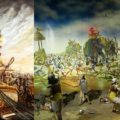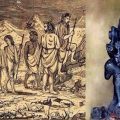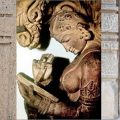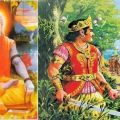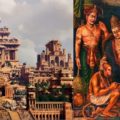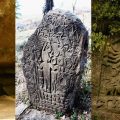A Debate on Chronological History of India from Ancient to Medieval Era
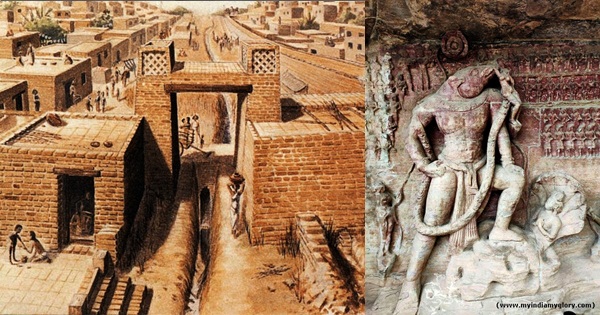
How old is the Indian civilization? Is the chronology of India from ancient to medieval period described in our history textbooks correct? Many scholars raise objections on the distorted datings. According to Western historians (and as per Wikipedia), Vedic era is between 1500 BCE to 600 BCE. Our civilization dates back to thousands of years. For example, Bhimbetka Caves, spread across 10 kms and housing 750 rockshelters, have evidences of paintings and human habitation that date back from 10,000 to 1 lakh years. The painting of Nataraja, the Dancing Mahadev at Rockshelter No 10, dates back to the Mesolithic era, which is 20,000 years beyond. Excavations on the banks of the Narmada have led to discovery of a fossil skull of the ancestor category of homo erectus that is nearly 5 to 6 lakh years old. So is the discovery of fossils in the same river banks that dates back to thousands and lakhs of years. Likewise, excavations in different regions of India including sea underwater explorations in the Gulf of Cambay, have led to discovery of artefacts that date back from 1000 to 12000 years and beyond.
What about the literary, inscriptional and epigraphical evidences that justify the antiquity and timeline of our civilization? If we club literary, inscriptional, epigraphical and finds from archaeological excavations, we arrive at a particular timeline. India is known for a healthy debate in ancient times. The Vadashastra speaks volume about the fact. Various research scholars have arrived at a certain timeline on the chronology of India from ancient to medieval period based on their individual researches.
Here is a debate on the chronology of India from ancient to medieval period among five scholars/researchers: Arun Upadhyay, Vedveer Arya, Jijith Nadumuri Ravi, Nilesh Nilkanth Oak, and Rayvikumar Pillai. Arun Upadhyay is a retired IPS officer; he is the author of 10 books and 80 research papers. Vedveer Arya is a civil servant and an officer of 1997 batch of Indian Defence Accounts Service (IDAS). A postgraduate in Sanskrit from University of Delhi, he is author of The Chronology of Ancient India. Jijith Nadumuri is a former scientist of ISRO who worked as part of the Chandrayan 1 study phase currently engaged in the research of geographical data present in the Mahābhārata. He owns the web-portal AncientVoice. He is an artist and has visualized many scenes from the Mahābhārata which was exhibited in different conference venues. Nilesh Nilkanth Oak is the author of When did the Mahabharata War Happen? The Mystery of Arundhati (2011), where he freshly evaluated astronomy observations of Mahabharata text. An Adjunct Professor at School of Indic Studies, Institute of Advanced Sciences, he is also the author of Bhishma Nirvana, and The Historic Rama. Rayvikumar Pillay is a passionate scholar of Indian history, an avid traveller, photographer, writer, counsellor, and teaches meditation.
Topic of Debate: Chronological history of India from ancient to medieval period.
Topic description: Major parts of Indian historical records were destroyed in 1000 years of foreign rule. British forged our history and created lot of false propaganda about Asoka, Kalinga, and Buddhism. Further, British dropped one zero from 15000 BCE and marked 1500 BCE as start of Indian/Vedic civilization (Based on Arun Upadhyay’s article titled: British Forgery in Indian History: False Propaganda About Aśoka, Kalinga and Buddhism (click here to read full article).
The Debate
Jijith Nadumuri Ravi: It is true that British distirted our history in different ways. But this dropping of zero to turn Vedic Age from 15000 bce to 1500 bce is a naive notion. Both 1500 bce date and 15000 bce date are nothing more than guesswork. Go through the brilliant analysis of Shrikant Talageri in his book Rigveda A Historical Analysis and Rigveda and Avesta the Final Evidence, which is also evaluated by Koenraad Elst, as per which a date between 2000 bce to 4000 bce is more likely for Rgveda. It also aligns with the early and mature phase of Harappan Sindhu Sarasvati civilization thus our greatest literary tradition matching well with our gereatest material culture, eliminating all the riddles of Bharatiya history.
Vedveer Arya: Srikant Talagiri dates Mandalas based on his own speculations. We have to date Rishis of Suktas not Mandalas. Koenraad Elst has no understanding of traditional chronology of India. After all, we have to establish the chronology based on sheet anchors not on personal perceptions.
Jijith Nadumuri Ravi: No language can survive such long durations like 10000 of years due to evolution of vocabulary and syntax turning it into one or more daughter languages. Evidence of the rate of change of Samskrtam is right there if you analyze how quickly it changed from Vedic Samskrtam to Samskrtam of Ramayana and then to Samskrtam of Kalidasa and the pace at which its daughter languages viz the north Indian languages emerged in as short as 500 and 1000 years. Malayalam emerged from Tamil in 500 years. Old English become hard to understand to Englishmen in just 500 years.
Thus, if Vedas were authored in 15000 bce it would have to be renderd in a different language than Samskrtam as we know it today because in 1000 years considerable and noticeable changes occur in a language in its vocabulary and phrasology and in 4000 to 5000 years the accumulated changes will make it a completely different language.
Talageri’s date of Rgveda placed at 2000 bce to 4000 bce is just the right place where it tallies with the observable evolution in Samskrtam as seen in Rgveda, Ramayana and Abhignana Shakuntalam.
Vedveer Arya: If so, why Sanskrit or Prakrit of Inscriptions is the same since more than 2300 years?
Vedveer Arya: If so, why Marathi, Hindi found in inscriptions is quite different from today’s Marathi and Hindi but no such effect on Sanskrit.
Jijith Nadumuri Ravi: To say no such effect on Samskrt we need Samskrt inscriptions dated from various dates like from 1000 bce, 2000 bce, 3000 bce, 4000 bce etc, and for those positing Vedas at 15000 bce, Samskrt inscriptions from 15000 bce too is needed.
Vedveer Arya: What I wanted to convey is that there is a difference between natural language and programmed language. Sanskrit is not a natural language. It was evolved from a natural language (proto-sanskrit) based on grammatic rules and regulations. Rigvedic Rishis evolved Vedic Sanskrit based on a grammar. Sanskrit Grammar has three distinct phases of evolution, i.e., Vedic Sanskrit, Post Vedic Sanskrit and Laukik Sanskrit. The evolution of Sanskrit Grammar of Laukik Sanskrit was complete in the beginning of Trata Yuga. This is the reason why Laukik Sanskrit is the same since the time of Treta Yuga.
Jijith Nadumuri Ravi: The oldest attested name of the language that is known today as Samskrtam is ‘Bhaasha’. The name ‘Samskrtam’ itself is not that old. The name ‘Samskrtam’ became popular after Paanini authored Ashtadhyayi and provided well defined grammer to ‘Bhaasha’. This happened in 6th to 4th century BCE as per numerous scholars. The well defined Samskrta grammatical rules defined by Paanini is not followed in Rgveda so it is from a time when this language was just another spoken natural language without any refinement and discrete grammar defined.
Are you suggesting a different date for Paanini?
Vedveer Arya: Panini was not the author of the first book on Sanskrit Grammar. He himself refers to 15 ancient grammarians.Pratishakhyas are the oldest texts of Vedic grammar. Total 84 ancient grammarians found mentioned in Pratishakhyas. Before Panini, Aindra vyakarana was popular. Panini simply re-engineered the methodology and covered entire subject less than 4000 sutras.Without grammar, Vedic Sanskrit is not possible. Certainly, a basic grammar was evolved before writing of Vedic suktas. Panini presents grammar for Vedic Sanskrit as well as laukik sanskrit. Panini’s contribution is; he presented grammar in minimum sutras possible.
Jijith Nadumuri Ravi: Yes there were grammarians before Paanini. But how old in the past do they stretch? 1000 or 2000 years more or for 15000 years? What is your speculation about the date of the oldest texts of Vedic grammer? For every language, people speak it first without worrying about any grammer and a grammer evolves only later. There is nothing in the language of Rgvada indicating that it is an artificial language. Besides Vedic language and Avestan language taken together shows every sign of a natural language family with dialectic variations. All evidence points to it being a natural human language having all characteristics of any other human language like vocabulary evolution, phraseological changes and dialectical variations tending towards spawning daughter languages and branching off sister languages. There is neither any literary evidence or insciptional evidence for any grammar work that predates Rgveda.
Vedveer Arya: Rigveda perfectly follows context-free grammar and Sandhi rules. These two features are not found in natural languages. My book on the chronology from Vedic era to medieval era is under publication. It will be available from Oct 19.
Jijith Nadumuri Ravi: Every language follows its own grammer and sandhi rules, all the while no body has yet discovered a grammer for it!
So, that doesn’t make Vedic language any special.
Vedveer Arya: Can you please name the natural language which perfectly follows context-free grammar and Sandhi rules?
Jijith Nadumuri Ravi: Yes, the word ‘perfection’ can cause problem here, because every language make exceptions to its own grammar and sandhi rules and Vedic language is no exception.
The reason for it is that evolution of language is a product of *collective* human consciousness. A grammer is later created after the language is spoken for considerable amount of time by the consciousness of a *single* individual or a countable number of individuals who are the grammarians. A grammer or sandhi rules is an attempt by the individual to understand the language developed by the collective. So the rules he defines about the language agrees with the language usage 99% cases but fails in 1% or rare cases. The reason for this failure is because language is always evolving, even on a daily basis and this evolution is slow so that you can’t recognize in a day or in a century but will show up in 1000 years and even more clearly in 5000 years. But this dynamism shows up whenever somebody tries to create a grammar for the language. The percentage of exceptions to grammatical rules indicate that the language is dynamic and is evolving and to some extend give a clue about the rate of evolution of the language at any given time. Like any other language Vedic language sure has exceptions to its sandhi rules and grammer.
A note on context freeness Most of it are the attribute of poetry. The rules of poetry cannot be mistaken for the rules of grammer. The rules of poetry allows for flexibility in the ordering of subject object verbs etc and this cannot be mistaken for the grammer of the language. Other languages too relax grammer rules and SVO context and order in poetry.
The order and harmony observed in Rgveda are emerging from rules of poetry such as the chandas, meters, relaxed SVO etc.
Vedveer Arya: Grammar of Natural languages is later created but grammar of programmed languages must be concurrently evolved. Is Syntax of computer languages later created? Similarly, Sanskrit grammar is the syntax of Sanskrit language. No poetry of natural language perfectly follows context free grammar. The words of Vedic mantras can be placed anywhere but the meaning will be the same. For instance: first mantra of Rigveda – Agnim ide Purohitam Yajnasya devam ritvijam hotaram ratnadhatamam. This mantra has 8 words. You can place these words anywhere in the mantra but the meaning will be the same. The concept of making Linga, Vachana, Vibhakti as integral part of every word is unique and artificially evolved and it cannot be natural.
Jijith Nadumuri Ravi: Precisely my point. The only languages that is evidently artificial is the computer languages. Vedic language do not qualify as an artificial language.
In case of computer language a single individual creates the grammar rules and then the language is created. The computer language strictly follows the grammer rules set by the language inventor or else it won’t compile. When the grammar was created for each computer language, who created it, all of these are well known.
Vedic language makes sufficient errors to its own rules (as against its grammer, defined later by some grammarian).
Just like Samskrt in any language, poetry allows to change word order (which what i mentioned as change in SVO – change in subject verb order) exactly like in the first verse of Rgveda अग्निमीळे पुरोहितं यज्ञस्य देवमृत्विजम् ।
होतारं रत्नधातमम् (Recitations with such word order change is very prominent in Anyonyam traditions, aiding to memorize the verses.)
Hence in english poetry we can have lines like,
Tell me not, this falsehood please!
-and-
This falsehood, please tell me not!
Which in pross will be
Please do not tell me this falsehood.
Same in any language like Malayalam, Hindi etc.
Vedveer Arya: I have already explained that having perfect context-free grammar and sandhi rules is not possible in natural languages. These two features have been artificially evolved by a community of Rishis to structure Vedic Sanskrit. Therefore, Sanskrit was a language of learned people since Vedic era. Can you say – “falsehood this not please do me tell”? But this can be said in Sanskrit and still it would be meaningful.
Jmijith Naduuri Ravi: Yes, Samskrt exhibits such extreme flexibility and this feature was once hilighted as a reason why Samskrtam was a candidate for creating a human computer interface language. For a few decades a lot of people in the IT field and others studying lingustics tried in this direction and failed. Till now Samskrt is not turned into a human machine language it was projected to be.
Why?
Because these people underestimated the ambiguity emerging due to the extreme flexibility in the word order (that too observed in practice, only in poetry and never in prose) especially caused by the random possibilities in the afixing of the nagation markers and other adjactives, like in the kind of sentance i quoted. This coupled with the rare but attested breaks in the rule means, the whole idea had to be dropped.
Nevertheless this feature alone cannot give artificial language status to Vedic language (i use the name Vedic language here because the name Samskrtam (meaning:- refined, processed), which implies a notion that the language is created ‘artificially’ from some spoken language – which you mentioned as ‘proto-Sanskrit’) is not a very ancient name. It is only attested around Paanini’s time. However the name ‘Bhaasha’ is more ancient.
In other words, the postulated “proto-Sanskrt”, is in reality, the Vedic language as seen in Rgveda, a natural spoken language, and Samskrtam-proper is the language after it was ‘processed’ / ‘refined’ by grammarians like Paanini.
Nilesh Nilkanth Oak: Few comments
(1) I see use (or dropping off) one zero from 15,000 to 1500 BCE as a metaphor (irrespective of the original intent of Arun Upadhyaya JI). I look at Arun Ji as a man of Indic resources, his memory is amazing and various references he can pull on many Indic subjects is truly marvelous. I have decisively shown many of his specific chronology claims to be false.
(2) I am not interested in commenting on the utter illogical stuff Jijith pours out every single opportunity he gets. He is a good artist and a good database/resource designer. HIs ancient voice is a work of love and dedication and many will find it useful. Unfortunately, this is where my praise for him must come to and end.
I am writing a series on one of his many encounters with me, where I am showing how he shows utter lack of scientific acumen and logical reasoning but even more critical ‘Integrity’. This will be written in multiple parts and while Jijith remains the focus of this series (because it is based on his interaction with me), the motivation to write it is not to highlight problematic nature of Jijith’s argumentation. Many others, equally well-meaning individuals, also, lack these skills and thus end up wasting the time of a few serious individuals.
(3) Vedveer Arya JI is a hardworking individual with expertise in epigraphs and numerous other subjects. I admire his dedication and courage to put forward his views/claims in books and papers. I have serious objections to his methodology, especially how he connects the dots to reach inferences. I am glad that he is generating a set of alternate claims for Yuga, Ramayana, Surya Siddhanta, Mahabharata, Manu-smruti, Rigveda, etc. These will be useful as we evaluate multiple claims based on scientific acumen and logical reasoning to arrive at the truth or the best approximation to the truth.
Jijith Nadumuri Ravi: I am not against any individual. I have served as a scientist in one of the most prestigious organization ISRO. Calling me unscientific is a great insult. I will continue to oppose the utterly unscientific stretchhing of Indian chronology with utter disregard to lingustic theories and archeological evidence. I have to intervene because so many well meaning patriots who love Bhaarata and its culture are brainwashed into this absolutely illogical dates. It has the effect that genuine scholarship like that has emerged from the like of Dr SR Rao and Sriikant Talageri will be ignored and people will run around to this race to stretch Indian chronology to absurd dates. This projects will get full Western support because it is good for them if all of Indian scholars and public are misled into wrong paths so that they will never be challaged on solid scholarship like the one produced by Talageri and Koenraad Elst.
Jijith Nadumuri Ravi: You are making the same mistske that all others who bring up these 10K plus dates of Veda Itihasa Puranas. Any result solely based on astronomy data cannot be taken at face value if it disagrees with other disciplines like linguistics and archaeology.
Archeology allows you to go as far as 7000 bce at sites like Bhirrana. Besides there are well established chronology of evolution of pottery, dress, habitation, animal domesticaton etc.
Linguistics mandates that language is dynamic and becomes irrecognizable in as many as, 5000 years. Besides, there are well established chronology of evolution of proper nouns used to name stars, planets, people etc.
Based on that it is very clear that Puranas are developed later to Vedas and Itihasas. Most Puranas talk about historically attested Nandas and Mouryas too. Most of it are thus authored later to these historic kings.
If you are getting dates defying these constraints from archeology and lingustics, the first thing you need to do is to check your vague assumptions (may, might, could be, could have been etc).
Now looking at your brief explanation, i can see dozens of vague assumptions made already, to arrive at dates like 17500 BCE.
Rayvikumar Pillai: Jijith Nadumuri Ravi wrong statement “Archaeology allows you to go as far as 7000 bce at sites like Bhirrana” for the white man, not for Hindus who used astronomical references as sheet anchor coupled with their texts. It is now understood that neither you have studied either texts nor have any explanation of astronomical references nor, genetic studies which clearly point to outward migration to Latin America around 17500BCE!! Absence of evidence is not absence of events, for that matter I am sure only white man’s ancestors descended from apes not us. We never mean to insult you but if you presume that because it does not fit into your so called ‘chronological order it must be fake’ is stretching our magnanimous behavior. There is no speculation by Vedveer Arya ji. Maybe u need to read and understand more. This may help unless you have grouse against those who don’t agree with you.
Featured image courtesy (Harappa): the betterindia.com; Right image of the ancient sculpture of Varaha in Udaigiri Caves clicked by author.

